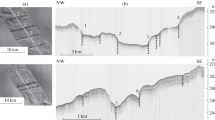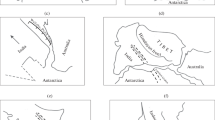Abstract
The Osborn Plateau is a large intraplate elevation in the eastern Indian Ocean, which has been poorly studied by geological and geophysical methods. On cruise SO258/1 aboard the R/V Sonne, new data were collected by Parasound seismic processing, multibeam survey, and, for the first time, dredging. Faults in the sedimentary cover, which extend to the seafloor surface, indicate high neotectonic activity in the area of the Osborn Plateau. It may have continued up to the present, as well as in the adjacent segment of the Ninetyeast Ridge, where strong earthquakes are recorded. Two reflectors A and C in the upper part of the sedimentary cover mark global regressive changes in the World Ocean level at the Pliocene–Pleistocene and Miocene–Pliocene and boundaries. Reflector B in sediments at the Lower–Upper Pliocene boundary is associated with a change in the regional hydrodynamic regime at the time in the eastern Indian Ocean. Reflector B at the Lower–Upper Pliocene boundary is associated with a change in the local hydrodynamic regime in the region of the plateau and was caused by uncompensated sedimentation. As a result of dredging, strongly altered vitroclastic tuffs were obtained, consisting of palagonized ash particles and lapilli. Analysis of geochemical data on the composition of palagonite made it possible to reconstruct the main geochemical features of the primary composition of glass in tuffs, in particular, high enrichment in incompatible elements (Nb, Zr, Ti, La, etc.). The results of studying the dredged rocks suggest that tuffs dredged on the Osborn Plateau were formed as a result of explosive volcanic eruptions of alkaline basalts under subaerial or relatively shallow conditions and represent the latest eruption products in the region.







Similar content being viewed by others
REFERENCES
G. L. Kashintsev, “Magmatism, geological history, and geodynamics of the bottom of the Indian Ocean (Paleocene–Pleistocene),” Geotektonika, No. 5, 70–81 (1994).
O. D. Korsakov and A. I. Pilipenko, “Tectonic deformations of the East Indian Ridge,” Dokl. Akad. Nauk SSSR 320, 407–411 (1991).
M. A. Levitan, Paleoceanology of the Indian Ocean in Cretaceous–Neogene (Nauka, Moscow, 1992) [in Russian].
O. V. Levchenko, “Cruise number KNOX06RR of the research vessel Roger Revelle (USA) in 2007: geological and geophysical explorations along the East-Indian Ridge,” Oceanology (Engl. Transl.) 49, 879–885 (2009).
O. V. Levchenko, R. A. Anan’ev, I. A. Veklich, et al., “Complex studies of submerged ridge in the northern segment of the East Indian Ridge,” Vestn. Kamchat. Reg. Assots. Uch.-Nauchn. Tsentra, Nauki Zemle 3 (39), 90–104 (2018).
O. V. Levchenko, Yu. G. Marinova, R. Werner, and M. V. Portnyagin, “Geological studies in the Eastern Indian Ocean: cruise SO258/1 of the R/V Sonne (Germany) with the Participation of Russian Researchers,” Oceanology (Engl. Transl.) 59, 276–278 (2019).
O. V. Levchenko, I. M. Sborshchikov, and Yu. G. Marinova, “Tectonics of the Ninety-East Ridge,” Oceanology (Engl. Transl.) 54, 231–244 (2014).
Yu. G. Marinova, “Stratigraphic hiatuses in the sedimentary cover of the Ninetyeast Ridge,” Stratigr. Geol. Correl. 26, 571–583 (2018).
V. E. Milanovskii, Candidate’s Dissertation in Geology-Mineralogy (Moscow, 1984).
A. I. Pilipenko, A. P. Bogomyakov, and V. D. Popov, “Early Cenozoic paleoaxis of growth on the East Indian Ridge and Osborne Plateau (Indian Ocean),” Dokl. Akad. Nauk SSSR 317, 949–953 (1991).
A. I. Pilipenko, L. B. Meisner, and V. M. Yubko, “Seismic stratigraphy of the sedimentary case of the East Indian Range and the Osborne Plateau,” Byull. Mosk. O-va. Ispyt. Prir., Otd. Biol. 79 (2), 24–29 (2004).
Yu. M. Pushcharovskii and P. L. Bezrukov, “Tectonics of the eastern part of the Indian Ocean,” Geotektonika, No. 6, 3–19 (1973).
Seismic Stratigraphy: Applications to Hydrocarbon Exploration, Ed. by C. E. Payton (American Association of Petroleum Geologists, Tulsa, 1977; Mir, Moscow, 1982).
N. M. Sushchevskaya, O. V. Levchenko, E. P. Dubinin, and B. V. Belyatsky, “Ninetyeast ridge: magmatism and geodynamics,” Geochem. Int. 54, 237–256 (2016).
ANSS comprehensive earthquake catalog (ComCat). https://earthquake.usgs.gov/data/comcat
D. Blackman, Project: VANCOUVER expedition, Leg 10, 2003. https://www.rvdata.us/search/cruise/ VANC10MV.
K. Cashman and A. Rust, “Introduction,” in Volcanic Ash, Ed. by S. Mackie, (Elsevier, Amsterdam, 2016), pp. 5–22.
GEBCO_2019Grid. https://www.gebco.net/data_ and_products/gridded_bathymetry_data.
GEOROC: Geochemistry of Rocks of the Oceans and Continents (Max Planck Institute for Chemistry, Mainz, 2018). http://georoc.mpch-mainz.gwdg.de/ georoc/. Accessed 2018.
R. Golowin, M. Portnyagin, K. Hoernle, et al., “The role and conditions of second-stage mantle melting in the generation of low-Ti tholeiites and boninites: the case of the Manihiki Plateau and the Troodos ophiolite,” Contrib. Miner. Petrol. 172 (11–12), 104 (2017).
F. A. Frey, M. Pringle, P. Meleney, et al., “Diverse mantle sources for Ninetyeast Ridge magmatism: geochemical constraints from basaltic glasses,” Earth Planet. Sci. Lett. 303 (3–4), 215–224 (2011).
W. E. Halter, T. Pettke, C. A. Heinrich, and B. Rothen-Rutishauser, “Major to trace element analysis of melt inclusions by laser-ablation ICP-MS: methods of quantification,” Chem. Geol. 183 (1), 63–86 (2002).
K. P. Jochum, B. Stoll, K. Herwig, et al., “MPI-DING reference glasses for in situ microanalysis: new reference values for element concentrations and isotope ratios,” Geochem., Geophys., Geosyst. 7, Q02008 (2006). https://doi.org/10.1029/2005GC001060
A. Kopf, D. Klaeschen, W. Weinrebe, et al., “Geophysical evidence for late stage magmatism at the central Ninetyeast Ridge, Eastern Indian Ocean,” Mar. Geophys. Res. 22, 225–234 (2001). https://doi.org/10.1023/A:1012297315620
K. S. Krishna, “Structure and evolution of the Afanasy Nikitin seamount, buried hills and 85° E Ridge in the northeastern Indian Ocean,” Earth Planet. Sci. Lett. 209, 379–394 (2003).
K. S. Krishna, H. Abraham, W. W. Sager, et al., “Tectonics of the Ninetyeast Ridge derived from spreading records in adjacent oceanic basins and age constraints of the ridge,” J. Geophys. Res.: Solid Earth 117, B04101 (2012). https://doi.org/10.1029/2011JB008805
K. S. Krishna, D. Gopala Rao, M. V. Ramana, et al., “Tectonic model for the evolution of oceanic crust in the northeastern Indian Ocean from the Late Cretaceous to early Tertiary,” J. Geophys. Res.: Solid Earth 100 (10), 20 011–20 024 (1995).
K. S. Krishna, D. Gopala Rao, L. V. Subba Raju, et al., Paleocene on-spreading–axis hotspot volcanism along the Ninetyeast Ridge: an interaction between the Kerguelen hotspot and the Wharton spreading center,” Proc.-Indian Acad. Sci., Earth Planet. Sci. 108 (4), 255–267 (1999).
M. T. Ledbetter, P. F. Ciesielski, N. I. Osborn, and E. T. Allison, “Bottom-current erosion in the southeast Indian and southwest Pacific Oceans during the last 5.4 million years,” in Antarctic Earth Science, Ed. by R. L. Oliver, (Cambridge University Press, Cambridge, 1983), pp. 379–383.
B. P. Luyendyk and W. Rennick, “Tectonic history of aseismic ridges in the eastern Indian Ocean,” Geol. Soc. Am. Bull. 88, 1347–1356. (1977).
I. G. Nobre Silva, D. Weis, J. S. Scoates, and J. Barling, “The Ninetyeast Ridge and its relation to the Kerguelen, Amsterdam and St. Paul Hotspots in the Indian Ocean,” J. Petrol. 54 (6), 1177–1210 (2013).
J. A. Pearce, “A user’s guide to basalt discrimination diagrams,” in Trace Element Geochemistry of Volcanic Rocks; Applications for Massive Sulphide Exploration, Short Course Notes vol. 12, Ed. by D. A. Wyman (Geological Association of Canada, St. John’s, 1996), pp. 79–113. http://georoc.mpch-mainz.gwdg.de/georoc.
J. Peirce, J. Weissel, et al., Proceedings of the Ocean Drilling Program, Initial Reports (College Station, TX, 1989), Vol. 121. https://doi.org/10.2973/odp.proc.ir.121.1989
J.-Y. Royer and R. G. Gordon, “The motion and boundary between the Capricorn and Australian plates,” Science 277, 1268–1274 (1997). https://doi.org/10.1126/science.277.5330.1268
J.-Y. Royer, J. W. Peirce, and J. K. Weissel, “Tectonic constraints on the hot-spot formation of Ninetyeast Ridge,” Proc. Ocean Drill Progr. Sci. Results 121, 763–776 (1991). https://doi.org/10.2973/odp.proc.sr.121.122.1991
W. W. Sager, Cruise report KNOX06RR R/V Roger Revelle, 2007. http://www.marine-geo.org/tools/ search/data/field/Revelle/KNOX06RR/docs/.
W. W. Sager, C. F. Paul, S. Krishna, et al., “Large fault fabric of the Ninetyeast Ridge implies near-spreading ridge formation,” Geophys. Res. Lett. 37, L17304 (2010). https://doi.org/10.1029/2010GL044347
A. D. Saunders, M. Storey, I. L. Gibson, et al., “Chemical and isotopic constraints on the origin of basalts from Ninetyeast Ridge, Indian Ocean: results from DSDP Legs 22 and 26 and ODP Leg 121,” Proc. Ocean Drill. Progr. 121, 559–590 (1991).
J. G. Sclater and R. L. Fisher, “The evolution of the east central Indian Ocean with emphasis on the tectonic setting of the Ninetyeast Ridge,” Geol. Soc. Am. Bull. 85, 683–702 (1974).
N. A. Stroncik and H.-U. Schmincke, “Palagonite—a review,” Int. J. Earth Sci. 91 (4), 680–697 (2002). https://doi.org/10.1007/s00531-001-0238-7
S.-S. Sun and W. F. McDonough, “Chemical and isotopic systematics of oceanic basalts: implications for mantle composition and processes,” in Magmatism in the Ocean Basins, Geological Society Special Publication vol. 42 (Geological Society of London, London, 1989), pp. 313–345.
P. R. Vail, R. W. Mitchum, and S. Thompson, “Global cycles and relative changes of sea level,” Am. Assoc. Petrol. Geol. Mem. 26, 83–97 (1977).
Proceedings of the Ocean Drilling Program, Scientific Results, Ed. by J. Weissel, J. Peirce, E. Taylor, et al. (College Station, TX, 1991), Vol. 121.
RV SONNE Fahrtbericht/Cruise Report SO258/1: INGO-N, The Indian—Antarctic Break-up Enigma, Fremantle (Australia)—Colombo (Sri Lanka) 07.06.–09.07.2017, GEOMAR Report No. 038, Ed. by R. Werner, H.-J. Wagner, and F. Hauff (GEOMAR Helmholtz-Zentrum für Ozeanforschung Kiel, Kiel, 2017). https://oceanrep.geomar.de/39238/.
G. Xu, F. A. Frey, D. Weis, et al., “Flood basalts from Mt. Capitole in the central Kerguelen Archipelago: Insights into the growth of the archipelago and source components contributing to plume-related volcanism,” Geochem., Geophys., Geosyst. 8, Q06007 (2007). https://doi.org/10.1029/2007GC001608
ACKNOWLEDGMENTS
The authors are grateful to captain of the R/V Sonne O. Meyer, the ship’s crew, and colleagues/participants in the research of cruise SO258/1.
Funding
R/V SONNE cruise SO258/1 has been carried under INGON project funded by the German Ministry for Education and Research (BMBF). The research of Russian scientists was funded by the state assignment of IO RAS, theme 0149-2019-0006; processing and interpretation of geophysical data was supported by the Russian Foundation for Basic Research (project no. 19-05-00680A).
Author information
Authors and Affiliations
Corresponding author
Rights and permissions
About this article
Cite this article
Marinova, Y.G., Levchenko, O.V., Portnyagin, M.V. et al. Composition of Volcanic Tuffs, Neotectonics, and Structure of the Upper Sedimentary Cover of the Osborn Plateau (Indian Ocean). Oceanology 60, 691–703 (2020). https://doi.org/10.1134/S000143702004013X
Received:
Revised:
Accepted:
Published:
Issue Date:
DOI: https://doi.org/10.1134/S000143702004013X




